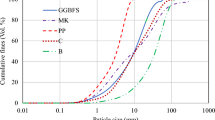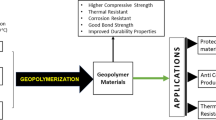Abstract
The influence of rice husk ash (RHA) on the thaumasite formation of cement pastes containing limestone powder was investigated. The specimens which were cured in 2 % MgSO4 solution were prepared with different ratios of coarse rice husk ash (CRHA) and fine rice husk ash (FRHA) to cement. The visual change of mortars was inspected monthly. Compressive strength, length and mass developments were examined as functions of time. The products of sulfate attack were examined by X-ray diffraction, Fourier transform infrared spectroscopy and Laser-Raman spectroscopy. The results showed that the degree of deterioration was retarded when cement was partially replaced by RHA. The use of FRHA showed better performance than those of the coarser ones. No obvious degeneration was observed in the mortar contains 20 % FRHA after 12 months of immersing in the MgSO4 solution.

Similar content being viewed by others
References
Clark, L.: The thaumasite form of sulfate attack: risks, diagnosis, remedial works and guidance on new construction. Report of the Thaumasite Expert Group. Department of the Environment, Transport and the Regions (1999)
Irassar E.: Sulfate attack on cementitious materials containing limestone filler—a review. Cem. Concr. Res. 39(3), 241–254 (2009)
Ma B. et al.: Thaumasite formation in a tunnel of Bapanxia Dam in Western China. Cem. Concr. Res. 36(4), 716–722 (2006)
Skaropoulou A., Kakali G., Tsivilis S.: A study on thaumasite form of sulfate attack (TSA) using XRD, TG and SEM. J. Thermal Anal. Calorim. 84(1), 135–139 (2006)
Hartshorn S., Sharp J., Swamy R.: Thaumasite formation in Portland-limestone cement pastes. Cem. Concr. Res. 29(8), 1331–1340 (1999)
Gaze M., Crammond N.: The formation of thaumasite in a cement: lime: sand mortar exposed to cold magnesium and potassium sulfate solutions. Cem. Concr. Compos. 22(3), 209–222 (2000)
Hartshorn S., Sharp J., Swamy R.: The thaumasite form of sulfate attack in Portland-limestone cement mortars stored in magnesium sulfate solution. Cem. Concr. Compos. 24(3), 351–359 (2002)
Barker A., Hobbs D.: Performance of Portland limestone cements in mortar prisms immersed in sulfate solutions at 5 C. Cem. Concr. Compos. 21(2), 129–137 (1999)
Bellmann F., Stark J.: Prevention of thaumasite formation in concrete exposed to sulphate attack. Cem. Concr. Res. 37(8), 1215–1222 (2007)
Smallwood I., Wild S., Morgan E.: The resistance of metakaolin (MK)–Portland cement (PC) concrete to the thaumasite-type of sulfate attack (TSA)—Programme of research and preliminary results. Cem. Concr. Compos. 25(8), 931–938 (2003)
Tsivilis S. et al.: Use of mineral admixtures to prevent thaumasite formation in limestone cement mortar. Cem. Concr. Compos. 25(8), 969–976 (2003)
Skaropoulou A., Kakali G., Tsivilis S.: Thaumasite form of sulfate attack in limestone cement concrete: the effect of cement composition, sand type and exposure temperature. Constr. Build. Mater. 36, 527–533 (2012)
Kakali G. et al.: Parameters affecting thaumasite formation in limestone cement mortar. Cem. Concr. Compos. 25(8), 977–981 (2003)
Baghabra O.S., Al-Amoudi M.M., Saadi M.M.: Effect of magnesium sulfate and sodium sulfate on the durability performance of plain and blended cements. ACI Mater. J. 92(1), 15–24 (1995)
Veiga K., Gastaldini A.: Sulfate attack on a white Portland cement with activated slag. Constr. Build. Mater. 34, 494–503 (2012)
Sousa Coutinho J.: The combined benefits of CPF and RHA in improving the durability of concrete structures. Cem. Concr. Compos. 25(1), 51–59 (2003)
Saraswathy V., Song H.-W.: Corrosion performance of rice husk ash blended concrete. Constr. Build. Mater. 21(8), 1779–1784 (2007)
Ramadhansyah P. et al.: Properties of concrete containing rice husk ash under sodium chloride subjected to wetting and drying. Proc. Eng. 50, 305–313 (2012)
Kathirvel P. et al.: Strength and durability properties of quaternary cement concrete made with fly ash, rice husk ash and limestone powder. Arab. J. Sci. Eng. 38(3), 589–598 (2013)
Ma B. et al.: Microscopic structure and growth mechanism of the corrosion products including thaumasite. J. Chin. Ceram. soc. 34(12), 1503–1507 (2006)
Bensted J., Varma S.P.: Studies of thaumasite—part II. Silic. Ind. 39(1), 11–19 (1974)
Hughes T.L. et al.: Determining cement composition by Fourier transform infrared spectroscopy. Adv. Cem. Based Mater. 2(3), 91–104 (1995)
Sahu S., Exline D.L., Nelson M.P.: Identification of thaumasite in concrete by Raman chemical imaging. Cem. Concr. Compos. 24(3), 347–350 (2002)
Mehta P.K.: Durability of concrete in marine environment—a review. ACI Spec. Publ. 65, 1–20 (1980)
Roy, D.: Hydration, structure, and properties of blast furnace slag cements, mortars, and concrete. ACI J. Proc. (1982)
Mehta, P.K.; Monteiro, P.J.: Concrete: Microstructure, Properties, and Materials, vol. 3, pp. 265–268. McGraw-Hill, New York (2006)
Bakharev T., Sanjayan J., Cheng Y.-B.: Sulfate attack on alkali-activated slag concrete. Cem. Concr. Res. 32(2), 211–216 (2002)
Giaccio G., de Sensale G.R., Zerbino R.: Failure mechanism of normal and high-strength concrete with rice-husk ash. Cem. Concr. Compos. 29(7), 566–574 (2007)
Köhler S., Heinz D., Urbonas L.: Effect of ettringite on thaumasite formation. Cem. Concr. Res. 36(4), 697–706 (2006)
Vuk T., Gabrovšek R., Kaučič V.: The influence of mineral admixtures on sulfate resistance of limestone cement pastes aged in cold MgSO4 solution. Cem. Concr. Res. 32(6), 943–948 (2002)
Nazari A., Bagheri A., Riahi S.: Properties of geopolymer with seeded fly ash and rice husk bark ash. Mater. Sci. Eng. A 528(24), 7395–7401 (2011)
Author information
Authors and Affiliations
Corresponding author
Rights and permissions
About this article
Cite this article
Ma, B., Wang, Y. & Fu, H. Effect of Rice Husk Ash on the Thaumasite Form of Sulfate Attack of Cement-Based Materials. Arab J Sci Eng 39, 8517–8524 (2014). https://doi.org/10.1007/s13369-014-1414-y
Received:
Accepted:
Published:
Issue Date:
DOI: https://doi.org/10.1007/s13369-014-1414-y




